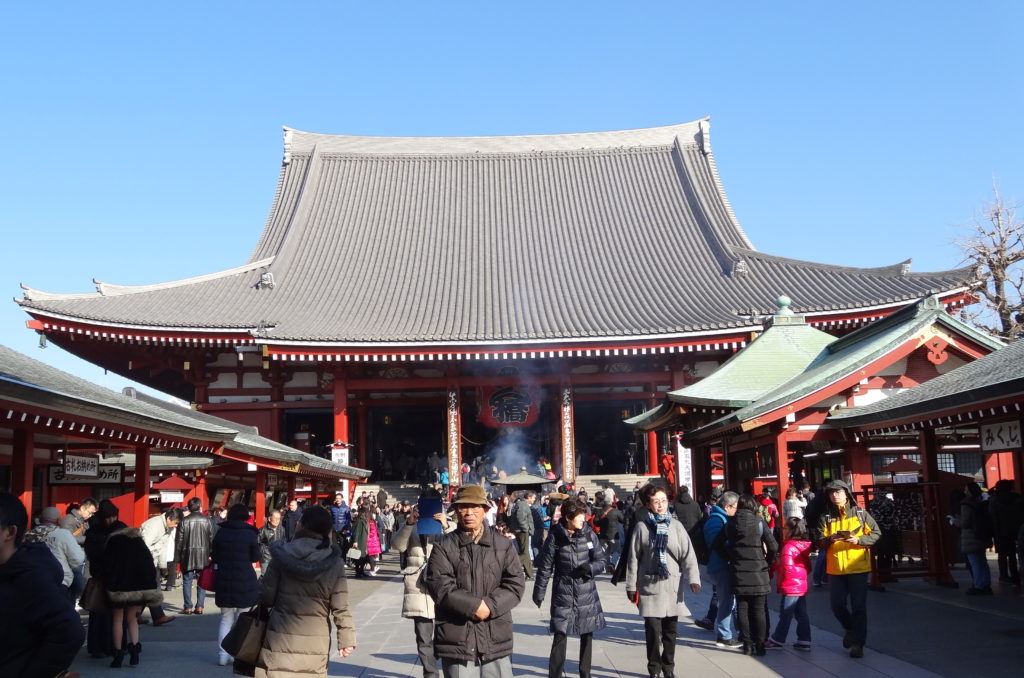Travel period Jan 2017
Visiting Sensoji Temple
Asakusa is one of the most popular spots and a historic district located in the east part of Tokyo. It is an older part of the city, but it has its charms. The Sensoji Temple (also known as The Asakusa Kannon Temple) grounds is one the main highlight of Asakusa area and just such a great place to explore!

Sensoji Temple
According to legend, in the year 628 two brothers fished a statue of Kannon (Goddess of Mercy) out of the Sumida River. Even though they threw it back into the river, it kept returning to them somehow. That’s why they build Sensoji Temple nearby in honour of Kannon (Goddess of Mercy). The temple was completed in 645 and make it its Tokyo’s oldest temple.

Interesting fact about Sensoji is that it is a conjugation of two words: “senso” is actually an alternate way of saying “Asakusa”; while “ji” is short for jingo or temple. Calling it Sensoji Temple is in essence a little redundant, but it’s been known as such for a long time so let’s just roll with it!
Visiting Sensoji Temple
Sensoji Temple (AKA Asakusa Kannon Temple) in Asakusa is the headquarters of the Sho-Kannon sect and Tokyo’s oldest temple, having been founded in 628 A.D.

Kaminarimon (Thunder Gate)
As we arrived at Sensoji, our attention is immediately drawn to its impressive gigantic red entrance gates called the Kaminarimon (Thunder Gate), is the famous outermost gate of Sensoji Temple, and the Asakusa district’s most famous landmark. On either side of the gate are the guard statues Fujin-sama (God of Wind) and Raijin-sama (God of Thunder).

Nakamise-dori

Entered through Kaminarimon, we immediately saw the Nakamise Shopping Street, which was basically a long stretch of 50 shops full of baubles, souvenirs, and local delicacies and street food. At the end of this lane were the main grounds of the Sensoji Temple.

Hozomon
Followed the Nakamise Shopping street lead us to the second gate called Hozomon. It’s also quite large and quite red. Apart from its guard statues, on the other side there were also a pair of giant waraji (straw sandals) hung on the other side of the gate. Apparently, these are made by roughly 800 people from Maruyama as thanks for engaging one of their own to be the sculptor of the guard statues for the Hozomon.

Kannondo Hall

The temple’s main hall (Hon-do) can immediately be spotted the moment we entered the gates. Kannondo Hall, where the god Kannon sits at the centre surrounded by other gods.
The Kannondo was first built in 1651, destroyed in World War II and rebuilt in 1958. The hall is said to hold a golden image of the Goddess of Mercy (Kannon) discovered by three fishermen in the 7th century.
In front of the temple building is a large cauldron of incense. We were watching what everyone else was doing and we just went up to it, wave the smoke towards the part of our body we want to be blessed, which was believed to bestow good health.

Goju-no-To (five-story pagoda)
To the left is the Goju No To (five-storey pagoda), rebuilt in 1973 and modelled after a similar structure at Daigoji Temple in Kyoto. Near the pagoda was Dembo-in – a picturesque tea garden built in the 17th century by noted landscape gardener, Enshu Kobori (1579-1647).

Getting to Asakusa
Asakusa is served by the Ginza Subway Line, Asakusa Subway Line, Tsukuba Express and Tobu Railways. It can also be accessed by the Tokyo Water Bus.
- From Tokyo Station: Take the JR Yamanote Line to Kanda Station (2 minutes, 140 yen) and transfer to the Ginza Subway Line for Asakusa (10 minutes, 170 yen).
- From Shinjuku Station: Take the orange JR Chuo Line to Kanda Station (10 minutes, 170 yen) and transfer to the Ginza Subway Line for Asakusa (10 minutes, 170 yen).
Opening hours:
Main hall: 06:00 to 17:00 (from 06:30 from October to March)
Temple grounds: Always open
Admission is Free!
Note: The information provided in this post was correct at time of publishing but may change. For final clarification please check with the relevant service.
You May Also Like

